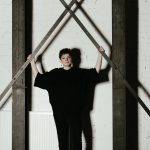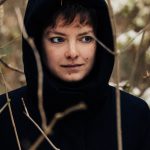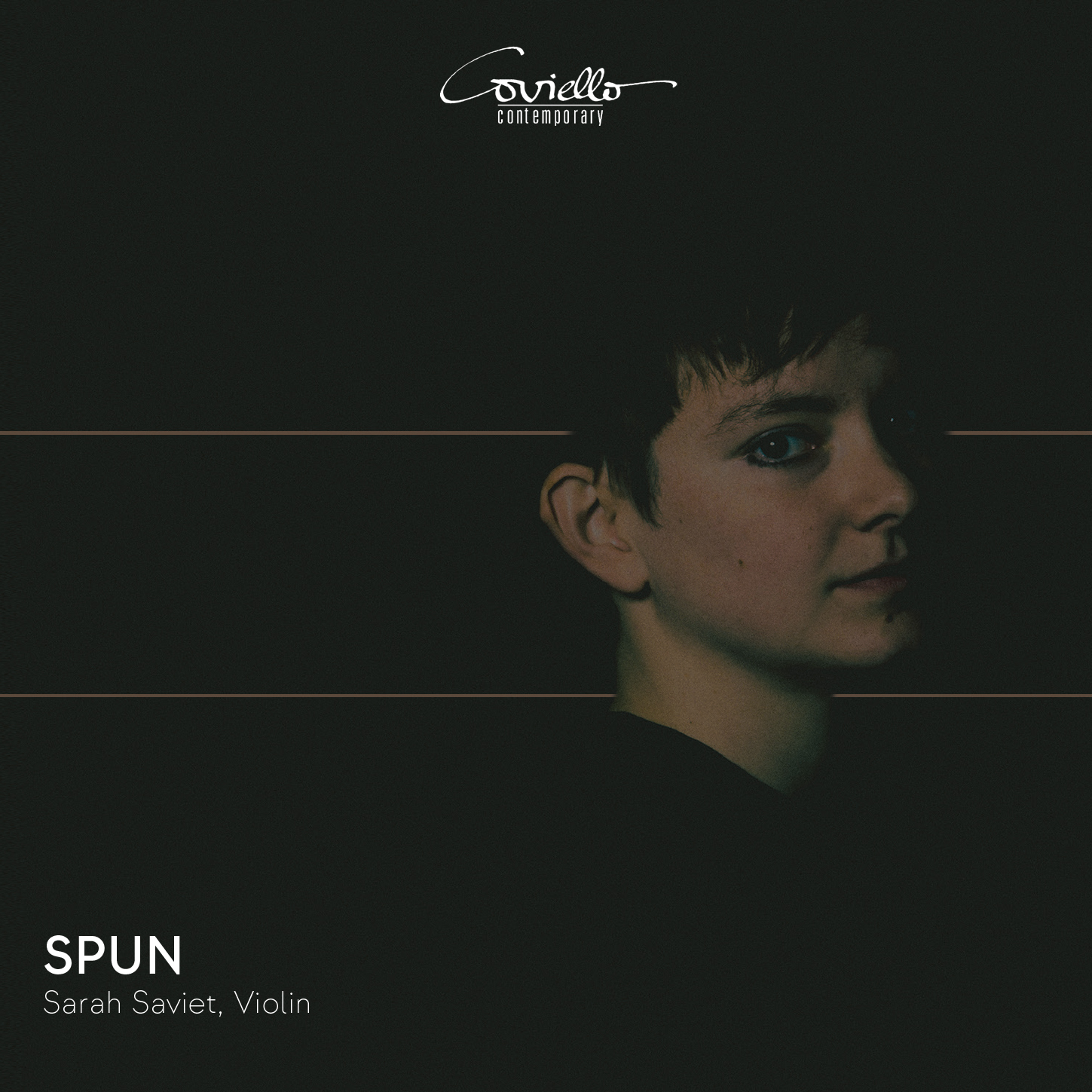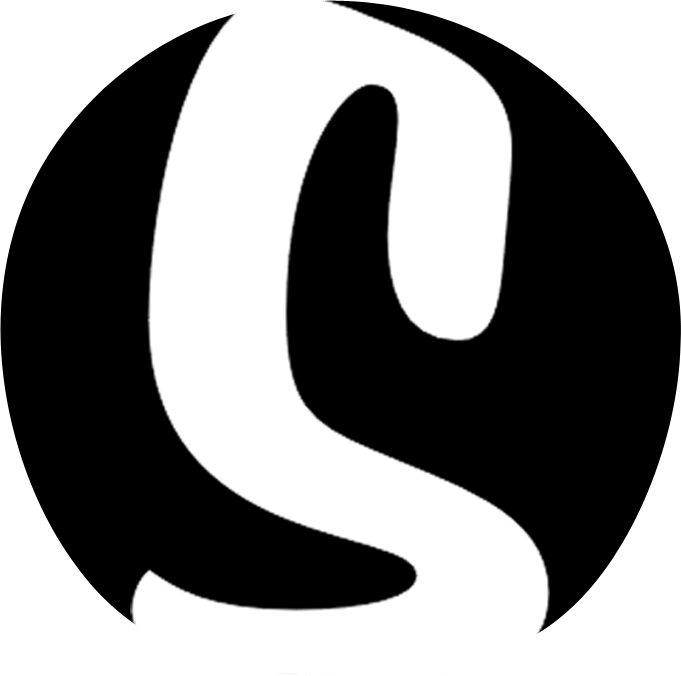Sarah Saviet: SPUN
All press enquiries to ssaviet@gmail.com
About the Album
Sarah Saviet is a violinist based in Berlin who performs extensively as a soloist and ensemble musician. Her multifaceted artistic practice encompasses extensive collaborations with composers, theater and movement work, and composition. Spun is Saviet’s debut solo album, a collection of physical and risk-taking works for solo violin. From incessant gestural retunings to barely audible wind-born phrases, these works explore the extremes of the instrument through five timbrally rich soundworlds.
In Liza Lim’s The Su Song Star Map, scordatura and throaty bow utterances create a tactile and sensual environment, while Lisa Streich’s Falter instructs the performer to ‘be a lepidoptera’ (moth or butterfly) and barely graze the strings. Evan Johnson’s Wolke über Bäumen played with gut strings and baroque bow involves constant re-tuning of the instrument, giving rise to fascinating inconsistencies and artefacts. The most overtly virtuosic work on the album, Arne Geishoff’s spun features bursts of flourishing melodies and sparks of fragmented passages. Lawrence Dunn’s Habitual offers an introspective resolution to the album, and focuses on a private expression of an inner song.
This release showcases the development and realisation of five distinct solo pieces, and exemplifies a significant aspect of Saviet’s practice – the process of long-term collaborative relationships with composers through and beyond these solo works.
Tracklist
- The Su Song Star Map (2018) by Liza Lim
- Falter (2020) by Lisa Streich
- Wolke über Bäumen (2016) by Evan Johnson
- spun (2018) by Arne Gieshoff
- Habitual (2017) by Lawrence Dunn
Sleeve Note
Replace your modern strings of steel and nylon with traditional gut. Warmer in sound but more wayward in tension. Tune each downwards by eight small, approximately even steps such that your instrument rings dark and unfamiliar. Choose a Baroque bow – several centimetres shorter and noticeably lighter. It dances easily as you play but requires new lines of attack and control. You will need to adjust weights and movements – and the sense of timing you have learnt through years of practice to attach to these. Your instrument writhes awkwardly, like a small animal cupped in your hands that must be continually coaxed and comforted.
This is the unfamiliar place from which a violinist begins Evan Johnson’s Wolke über Baumen. And the challenges only go on from here. Over the course of the piece, at thirty-two points marked in the score, those steps in detuning (or scordatura) are reversed, so that by the end something like the standard tuning of G-D-A-E is reached once more. But in practice – and by design – this is hardly possible: the speed of performance itself means the steps down cannot be precisely rewound; furthermore, the inherent instability of gut strings makes it impossible to judge how much impact a small turn of the tuning peg will have. The tiny pops of those turns are incorporated into the music’s sonic palette, which balances dense cracks of sound with tense, highly concentrated distillations of near silence – echoes of the Paul Klee drawing of clouds and jagged forest after which the piece is named.
In his essay ‘The Cello and the Lasso’, the British anthropologist Tim Ingold describes the certain kind of ‘enchantment’ that is required of Sámi reindeer hunters in the forests of northern Finland. In luring their prey (or, equally, becoming lured by it), hunters must follow its lines of being – its paths through the forest, its moods and temperaments, its fears and desires. Dressed in reindeer hides, the hunter must almost become his prey, so deeply attuned to its feelings and movements must he be. Ingold uses enchantment in a musical sense, meaning the act of joining with a singer in the linear realisation of a song. As an amateur cellist, he observes that making music is much like hunting. Just as the hunter pursues his prey by means of entangled correspondence, ‘likewise when I play, my gestures, my touch and my awareness are comprehensively caught in the resonances and reverberations of the instrument’.
As for the cello so it is for the violin. Wolke über Baumen represents an extreme instance, but each piece on this recording by the Berlin-based violinist Sarah Saviet requires particular and unique adjustments to those resonances and reverberations, and therefore particular and unique states of enchantment in their playing. The Su Song Star Map by Liza Lim asks for a retuning of the violin’s G string down by a minor third to an E – creating new sympathetic resonances with the high E string and changing the profile of the overtones that can be brought out on the instrument. Lawrence Dunn’s Habitual makes use of 5-limit just intonation (a tuning system based on pure octaves, fifths and major thirds), meaning that certain pitches sound slightly flatter than their equally tempered counterparts, altering not only how the player fingers each pitch but also how they contextualise it within the music. And while the pieces by Arne Gieshoff and Lisa Streich do not ask for special tunings, they do make use of a wealth of different bowing and fingering techniques that shape the music across varied landscapes of touch and sound.
Negotiating such subtle and conflicting forces induces a kind of enchantment in both player and careful listener. (And in Streich’s Falter, enchantment applies in a more hunterly sense too, as the player is asked to become like an insect, the music’s speed and motion choreographing their bow arm like the wing of a moth.) Such an ‘enchanted traveller’ is, as Ingold puts it, ‘one who, at every such moment, opens his or her senses to the world as if for the first time’. Or, as Saviet herself puts it in relation to the scordatura of The Su Song Star Map, ‘It feels like wearing a different texture of clothing. Your senses are activated in a different way; the way you’re touching everything is a little bit different.’
Like the reindeer of the Sámi hunter, these pieces play her as much as she plays them: the friendships they represent are closely bound to the sounds they make. Gieshoff is an especially close and important musical co-traveller; Saviet met him in Cologne shortly after they were both beginning their professional lives. Spun began as fünf formen, versponnen and it has steadily evolved over the years the two musicians have worked on it together; Saviet values it especially for the opportunities it gives her to explore forms of virtuosity as well as different soundworlds and colours. Likewise, Lim’s music, which Saviet has performed since 2016 (including a recording of Lim’s violin concerto Speak, Be Silent, with Riot Ensemble), has opened her awareness to a range of sounds that she has been able to incorporate into her other playing: particularly the lower string sounds (‘which I love’) and a throaty, raspy, vocal approach to the relationship of bow and string. (Lim’s performance notes to The Su Song Star Map ask for a distorted sound like ‘a singer’s catch in the throat or a veil of whisky and cigars’.) Saviet’s physical relationship to her instrument has also been altered by playing Lim’s music – not in terms of athletic exertion, but in a way of ‘digging into’ the strings that produces vocality, warmth and distortion from within the body and the sound rather than imposing them from without.
Like Gieshoff, Dunn has become another close musical friend. Habitual began with the idea of Saviet sitting at home at night, playing the piece to herself. The score is headed with the instructions ‘Interior, privately’, and Saviet admits to a particular vulnerability when playing it: in comparison to Johnson’s music, it requires a deliberate effort not to reveal too much to the audience. As well as the tunings, the rhythms are slightly off kilter (Dunn makes use of a kind of half-dotted rhythm that adds fractional lengths to certain notes). The result is a sort of unpolished mode of address, as though the violinist is, indeed, talking to (or playing to) herself alone. Through playing Johnson’s music, meanwhile, Saviet has found yet another way of relating to her instrument in negotiating and balancing the multiple interacting layers of information the composer inscribes on his scores. The exploration of inwardness this requires – ‘a really intense conversation with myself’ – bring her close to her reasons for playing music at all. ‘Here I am, with myself and these sounds’, she explains. ‘And I have these many things to deal with in the sound. Some of that will come out to the people who are listening, and I can choose what I want to give and what stays inside of me.’
Ingold puts it better still: ‘The beauty of exposure lies not in the finessed display of forms from which all evidence of their production has been assiduously erased or covered up … but in an opening up of the inner workings of things which turn the lives of practitioners inside out. Abandoning the realms of studied perfection in which everything is complete but nothing is what it seems we cast off into the aleatoric indeterminacy of a world-in-formation whose very imperfections afford possibilities for continuation. This casting off – this opening up of the self, from the inside – amounts to an offering.’
Tim Rutherford-Johnson, 2023
Sarah Saviet
Sarah Saviet is a violinist based in Berlin and dedicated to the performance of contemporary music. She performs as a soloist and chamber musician and is a member of the Saviet/Houston Duo and Ensemble Mosaik. Sarah’s recording of Liza Lim’s violin concerto ‘Speak, Be Silent’ with the Riot Ensemble was selected as one of New Yorker Magazine’s ‘Best recordings of 2019.’Recent performances include soloing with Klangforum Wien as part of Märzmusik in the Berliner Philharmonie, and the premiere of Rebecca Saunders and Enno Poppe’s duo Taste at Witten Festival 2022. Sarah has held visiting artist positions in the composition departments of the University of the Arts Berlin, Huddersfield University, at Goldsmith University London with the Riot Ensemble, and at Harvard University with ELISION Ensemble. She has given workshops on contemporary violin technique at the Manhattan School of Music University of the Arts Berlin, Manhattan School of Music, and Darmstadt Akademie für Tonkunst, and held artist residencies at Aldeburgh Music with composers Lawrence Dunn, Jack Sheen, and artist Rowland Hill.Sarah performs frequently in festivals such as Huddersfield Contemporary Music Festival, Donaueschinger Musiktage, Gaudeamus Muziekweek, Acht Brücken Köln, Märzmusik Berlin, Amsterdam String Quartet Biennale, Lucerne Festival, and Dark Music Days in Iceland. www.sarah-saviet.com




